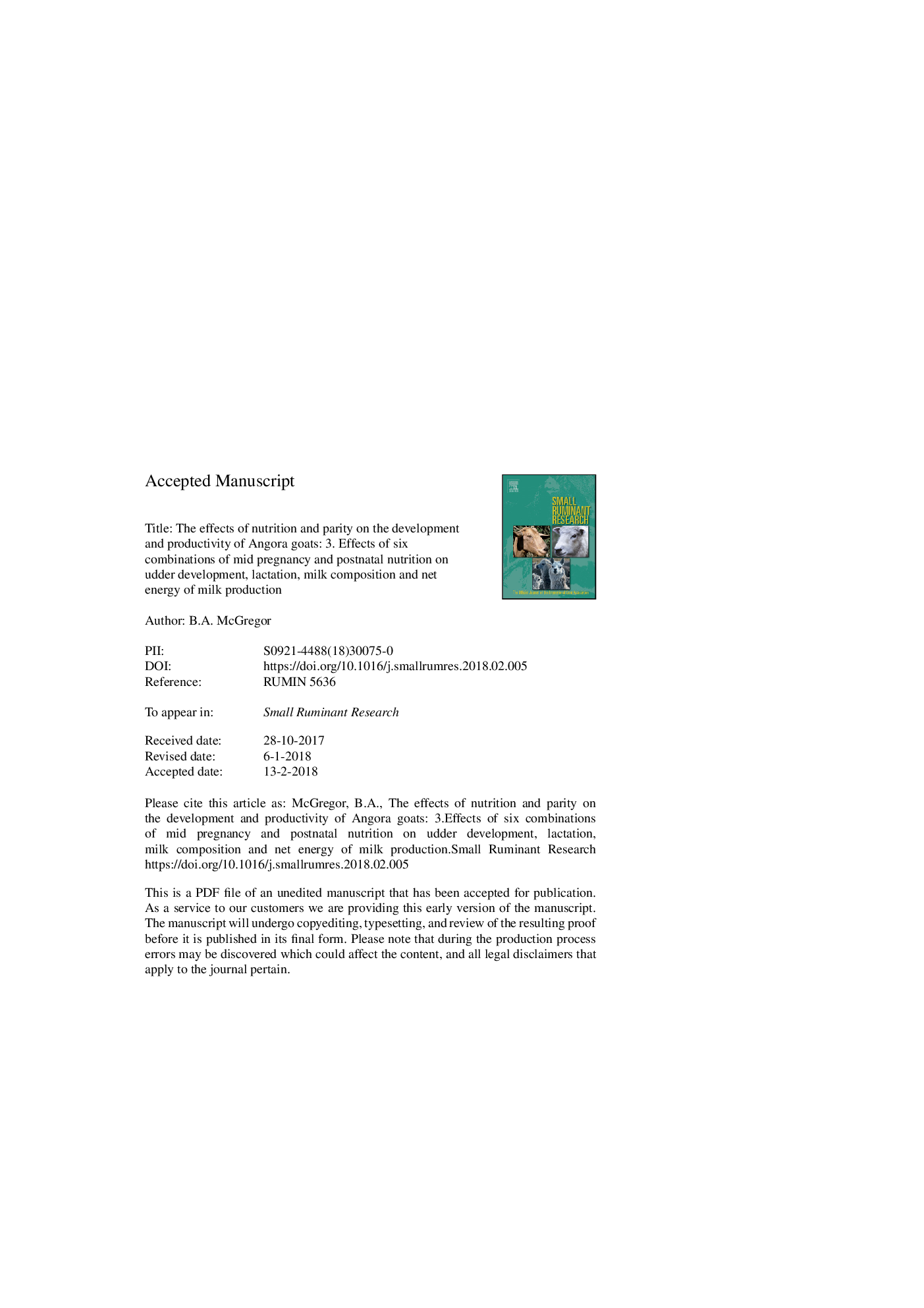| کد مقاله | کد نشریه | سال انتشار | مقاله انگلیسی | نسخه تمام متن |
|---|---|---|---|---|
| 8504220 | 1554331 | 2018 | 11 صفحه PDF | دانلود رایگان |
عنوان انگلیسی مقاله ISI
The effects of nutrition and parity on the development and productivity of Angora goats: 3. Effects of six combinations of mid pregnancy and postnatal nutrition on udder development, lactation, milk composition and net energy of milk production
ترجمه فارسی عنوان
اثرات تغذیه و زوال بر رشد و بهره وری بز های آنگورا: 3 اثر شش ترکیب بارداری میانه و تغذیه پس از زایمان بر رشد پستان، شیردهی، ترکیب شیر و انرژی خالص تولید شیر
دانلود مقاله + سفارش ترجمه
دانلود مقاله ISI انگلیسی
رایگان برای ایرانیان
کلمات کلیدی
موضوعات مرتبط
علوم زیستی و بیوفناوری
علوم کشاورزی و بیولوژیک
علوم دامی و جانورشناسی
چکیده انگلیسی
Recommendations for the nutrient management of lactating Angora goats are mostly based on theoretical calculations as little empirical data is available. This report investigates the combined effects of 3 levels of mid pregnancy nutrition (MPN)â¯Ãâ¯2 levels of postnatal nutrition during lactation (PNN) providing 6 nutrition patterns, with both single and twin bearing does, on milk production and composition and energy requirements for milk production. Following artificial insemination and pregnancy scanning, does were fed pelleted rations in individual pens in an outdoor feedlot from day 47 of pregnancy until 13 weeks postpartum. MPN treatments commenced from day 47 as follows: Control (C), fed to lose live weight (â67â¯g/d); Maintenance (M), does fed to maintain live weight; Supplemented (S), does fed to gain live weight at 102â¯g/d. From days 105 of pregnancy until 4â¯days postpartum the feeding level was ad libitum for all treatments. From 4â¯days postpartum PNN treatments were: ad libitum (AL) to allow maximum ME intake resulting in live weight gain throughout lactation; Restricted (R) to 70% of AL, resulting in live weight loss until week 10 of lactation. MPN had no effects on milk production. Milk production was affected by PNN and parity at days 21 and 42 of lactation but not at day 90. R fed does secreted 21% less milk at day 21 of lactation (1.75 vs. 1.38â¯kg) and 29% less at day 42 of lactation (1.74 vs. 1.24â¯kg) compared with AL fed does. Milk production corrected to 4% fat exceeded 2.8â¯kg/d until day 42 of lactation in AL fed does. Both MPN and PNN affected the concentration of milk solids. MPN had no effect on secretion of milk solids. PNN affected total secretion of milk fat, protein, lactose and total solids at days 21 and 42, with AL fed does producing more than R fed does. Both MPN and PNN had separate independent effects on NEl. For MPN, S fed does had milk with higher NEl than that of M and C fed does (C, 5.256; M, 5.320; S, 5.683â¯MJ/kg; Pâ¯<â¯0.05). For PNN, R fed does had milk with higher NEl than that of AL fed does (R, 5.614; AL, 5.226â¯MJ/kg; Pâ¯=â¯0.005). Total NE secreted in milk was affected by stage of lactation (Pâ¯<â¯0.001) and separate effects of PNN (Pâ¯=â¯0.001) and parity (Pâ¯=â¯0.014). There were significant correlations between udder dimensions and milk production and composition. Higher ME intake was associated with higher milk production (days 21 and 42), and higher body condition score was associated with higher milk production. At day 42, does rearing male kids had greater milk production compared those rearing female kids. Does with udders of greater volume produced more milk. Total milk production during lactation was highest for AL fed twin rearing does at 201â¯kg and lowest for R fed single rearing does at 85â¯kg. Both milk production and milk fat composition were substantially greater than earlier reports for Angora does. The results indicate that previously suggested daily ME requirements of lactating Angora does and their potential daily milk yield need substantial upwards revision.
ناشر
Database: Elsevier - ScienceDirect (ساینس دایرکت)
Journal: Small Ruminant Research - Volume 161, April 2018, Pages 13-23
Journal: Small Ruminant Research - Volume 161, April 2018, Pages 13-23
نویسندگان
B.A. McGregor,
